2025-04-15 Tue
■ #5832. なぜ古英語の語順規則は緩かったのか? --- 語順の2つの原理から考える [word_order][oe][pde][japanese][linearity][syntax][information_structure][article][cleft_sentence][passive][voice][discourse]
1週間前の火曜日に heldio にて「#1413. なぜ古英語の語順規則は緩かったのか?(年度初めの生配信のアーカイヴ)」を生配信し,土曜日にそれをアーカイヴとして配信しました.語順 (word_order) という,言語において一般的な話題なので,関心をもたれたのでしょうか,おかげさまでこの回は平均よりも多く聴取されています.ありがとうございます.
英語史の分野で「語順」といえば,現代英語では語順規則が厳しいのに,古英語では語順が比較的緩かったという対比が話題になります.当然ながら「それはなぜ?」という素朴な疑問が湧いてくるのではないでしょうか.今回の話題は,この疑問に直接答えるものではなく斜めからのアプローチではありますが,語順とは何かという根本的な問題には真正面から取り組んでいると思います.
以下に文章で要旨を示しますが,ぜひ臨場感のあるオリジナルの音声配信にてお聴きいただければと思います.
1. そもそも「語順」とは何か? --- 言語の線状性 (linearity)
私たちは,外国語学習,特に英語学習を通じて,語順の重要性を学びます.現代英語は SVO が基本であり,これを崩すと意味が変わったり,非文法的になったりすると教わってきました.例えば I eat a banana. が標準的であり,*Eat I a banana. や *A banana I eat. は通常許容されません(強調などの特殊な文脈は除きます).
一方,日本語では「私はバナナを食べる」 (SOV) が自然ですが,「バナナを私は食べる」 (OSV) や「食べる,私はバナナを」 (VSO) なども,不自然さはあるにせよ,文法的に間違いとは言い切れません.
では,なぜ言語には語順というものが存在するのでしょうか.それは,言語が音声(あるいは文字)を時間軸に沿って直線的に並べることによって成立しているからです.これを言語の線状性と呼びます.私たちの発音器官(とりわけ声帯)は基本的に1つしかないので,複数の単語を同時に発することはできません.したがって,単語を順番に並べるしかないのです.これは言語における避けられない制約であり,物理学における重力に相当するものと捉えることができます.
While the dog is running in the yard, the cat is sleeping on the hot carpet. (犬が庭で走っている間,猫はホットカーペットの上で寝ている)という文は,本来同時に起こっている出来事を表わしていますが,言語の線状性の制約から,どちらかの節を先に言わざるを得ません.もし仮に人間が2つの声帯をもち,同時に2つの単語を発することができたなら,言語の構造は全く異なっていたことでしょう.
2. 語順規則の2つの原理
単語を順番に並べなければならないという,語順の存在理由は分かりました.しかし,問題は「どのように並べるか」という語順規則です.世界の言語を見渡すと,この語順規則の背後には,大きく分けて2つの異なる原理が存在するように思われます.
(1) 文法上の語順規則
・ 文(センテンス)内部の要素(主語,動詞,目的語など)の配置を固定する原理
・ 要素の文法的な機能(主語なのか目的語なのか)を語順によって示す傾向が強い
・ 典型例:現代英語 (SVO),中国語 (SVO) など
・ 文法的な関係性が語順によって明確になる反面,語順の自由度は低い
(2) 文脈上の語順規則
・ 文(センテンス)よりも広い文脈(談話)における情報の流れを重視する原理.
・ 多くの場合,主題・テーマ・旧情報を先に提示し,それに続く形で叙述・レーマ・新情報を配置する傾向がある
・ 典型例:日本語,古英語
・ 情報の流れが自然になる一方,文内部の語順は比較的自由で「緩い」と見なされやすい.
日本語の「昔々あるところに,おじいさんとおばあさんがいました.おじいさんは山へ芝刈りに・・・」という語り出しを考えてみましょう.最初の文では,舞台設定の後,新情報である「おじいさんとおばあさん」が「が」を伴って現れます.次の文では,既知となった「おじいさん」が「は」(主題)を伴って文頭に来て,新しい情報(山へ芝刈りに行ったこと)が続きます.このように,日本語は文脈上の情報の流れ(主題→叙述,テーマ→レーマ,旧情報→新情報)を語順や助詞によって表現することを好む言語なのです.
3. 古英語は日本語型だった?
さて,ここで古英語に注目してみましょう.なぜ古英語の語順規則は緩かったのか? 答えは,古英語が現代英語のような「文法上の語順規則」を第1原理とする言語ではなく,むしろ日本語に近い「文脈上の語順規則」を重視する言語だったからです.
古英語では,文脈に応じて,主題や旧情報と見なされる要素を文頭に置き,新情報を後に続けるという語順が好まれました.そのため,文の内部構造だけを見ると,SVO も SOV も VSO も可能であり,現代英語話者の視点から見ると,語順が固定されておらず緩い,と感じられるわけです.しかし,それは「規則がない」わけではなく,異なる種類の原理に基づいているものと理解すべきものなのです.
4. 語順原理の転換と英語史上の変化
英語の歴史は,この「文脈上の語順規則」を重視するタイプから「文法上の語順規則」を重視するタイプへと,言語の基本的な性格が大きく転換した歴史であると捉えることができます.この転換は,中英語期に顕著になり,近代英語期にかけて固定化していきます.この大きな原理の転換は,単に語順だけでなく,英語の他の様々な文法項目にも連鎖的な影響を及ぼしました.
・ 冠詞 (article) の発達:古英語にも冠詞の萌芽はありましたが,現代英語ほど体系的なカテゴリーではありませんでした.旧情報を示す定冠詞 the や,新情報を示す不定冠詞 a/an が発達してきたのは,まさに情報構造 (information_structure) を語順以外の方法で示す必要性が高まったことと関連していると考えられます.
・ 強調構文 (cleft_sentence) の発達:古英語では,強調したい要素を比較的自由に文頭に移動させることが可能でした.しかし,語順が固定化されると,そのような移動が制限されます.その代わりとして,It is ... that ... のような強調構文が発達し,特定の要素を際立たせる機能をもつようになりました.
・ 受動態 (passive) の多用:古英語にも受動態は存在しましたが,使用頻度は現代英語ほど高くありませんでした.語順が固定化される中で,本来目的語となる要素(新情報になりやすい要素)を主題として文頭に置きたい場合に,受動態が便利な装置として頻繁に用いられるようになってきたものと考えられます.例えば,目的語を文頭に置く OSV の語順が使いにくくなった代わりに,目的語を主語にして文頭に置く受動態が好まれるようになった,という見方です.
5. まとめ
古英語の語順が現代英語から見て「緩い」のは,語順規則がなかったからではなく,現代英語とは異なる「文脈上の語順規則」という原理をより重視していたためです.この原理は,くしくも日本語と共通する部分が多くあります.英語の歴史は,この基本原理が大きく転換したダイナミックな過程であり,その影響は英文法の様々な側面に及んでいるのです.
古英語を学ぶ際には,現代英語の固定的な語順観から一旦離れ,「情報の流れ」という視点をもつことが,かえって理解の助けになるかもしれません.日本語母語話者にとっては,むしろ馴染みやすい側面もあるといえるでしょう.語順という切り口から,英語の奥深い歴史を探求してみるのも,おもしろいのではないでしょうか.
2025-02-16 Sun
■ #5774. 朝カルシリーズ講座の第11回「英語史からみる現代の新語」をマインドマップ化してみました [asacul][mindmap][notice][kdee][etymology][hel_education][lexicology][cosmopolitan_vocabulary][pde][word_formation][morphology][neologism][borrowing][loan_word][shortening][link]
2月8日に,今年度の朝日カルチャーセンター新宿教室でのシリーズ講座「語源辞典でたどる英語史」の第11回が開講されました.今回は「英語史からみる現代の新語」と題して,様々な新語導入法を導入しつつ,具体的な現代の新語を紹介しました.また,歴史的な観点から現代英語の新語導入の特殊性に触れました.
現代の新語導入は他言語からの借用 (borrowing) にさほど依存しないという点で,英語史上特異な様相を呈します.一方,現代英語は,短縮 (shortening) という新しい語形成の型を獲得し,それへの依存度を高めてきました.直近100年ほどで,新語導入のトレンドが変わってきたと考えられます.21世紀の英語語彙は,どのように展開していくのでしょうか.
今回の講座は,対面で参加された方がいつも以上に多く,オンラインで参加された方からも質問をいただくなど,活発でインスピレーションに富む回となりました.感謝いたします.第11回の内容を markmap というウェブツールによりマインドマップ化して整理しました(画像としてはこちらからどうぞ).復習用にご参照いただければ.
今回のシリーズ第11回の話題に直接・間接に関わるコンテンツを,hellog と heldio の過去回で取り上げてきましたので,以下をご参照ください.
・ hellog 「#5764. 2月8日(土)の朝カルのシリーズ講座第11回「英語史からみる現代の新語」のご案内」 ([2025-02-06-1])
・ heldio 「#1345. 2月8日(土)の朝カル講座「英語史からみる現代の新語」に向けて」 (2025/02/03)
・ heldio 「#1349. 語根創成 --- ゼロから作る完全に任意の新語をめぐって」 (2025/02/07)
・ heldio 「#1350. CNN English Express 2025年2月号の特集「英語の新語30」」 (2025/02/08)
また,シリーズ過去回のマインドマップについては,以下もご参照ください.
・ 「#5625. 朝カルシリーズ講座の第1回「英語語源辞典を楽しむ」をマインドマップ化してみました」 ([2024-09-20-1])
・ 「#5629. 朝カルシリーズ講座の第2回「英語語彙の歴史を概観する」をマインドマップ化してみました」 ([2024-09-24-1])
・ 「#5631. 朝カルシリーズ講座の第3回「英単語と「グリムの法則」」をマインドマップ化してみました」 ([2024-09-26-1])
・ 「#5639. 朝カルシリーズ講座の第4回「現代の英語に残る古英語の痕跡」をマインドマップ化してみました」 ([2024-10-04-1])
・ 「#5646. 朝カルシリーズ講座の第5回「英語,ラテン語と出会う」をマインドマップ化してみました」 ([2024-10-11-1])
・ 「#5650. 朝カルシリーズ講座の第6回「英語,ヴァイキングの言語と交わる」をマインドマップ化してみました」 ([2024-10-15-1])
・ 「#5669. 朝カルシリーズ講座の第7回「英語,フランス語に侵される」をマインドマップ化してみました」 ([2024-11-03-1])
・ 「#5704. 朝カルシリーズ講座の第8回「英語,オランダ語と交流する」をマインドマップ化してみました」 ([2024-12-08-1])
・ 「#5723. 朝カルシリーズ講座の第9回「英語,ラテン・ギリシア語に憧れる」をマインドマップ化してみました」 ([2024-12-27-1])
・ 「#5760. 朝カルシリーズ講座の第10回「英語,世界の諸言語と接触する」をマインドマップ化してみました」 ([2025-02-02-1])
次回の朝カル講座は.3月15日(土)17:30--19:00に開講予定です.シリーズの最終回となる第12回で,「勘違いから生まれた英単語」と題して,オモシロ語源をもつ英単語を取り上げつつ,英語語彙史を総括する予定です.ご関心のある方は,ぜひ朝日カルチャーセンター新宿教室の「語源辞典でたどる英語史」のページよりお申し込みください.
・ 寺澤 芳雄(編集主幹) 『英語語源辞典』新装版 研究社,2024年.
2023-09-10 Sun
■ #5249. 川端朋広先生と現代英語の言語変化をいかに研究するかについて対談しました [voicy][heldio][review][corpus][pde][syntax][philology][methodology][link]
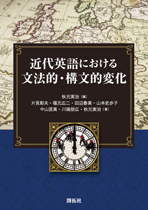
『近代英語における文法的・構文的変化』が,6月に開拓社より出版されています.15--20世紀の英文法およびその変化が実証的に記述されています.本書のユニークな点は,6名の研究者の各々が各世紀の言語事情を定点観測的に調査していることです.個々の章を読むのもよいですし,ある項目に注目して章をまたいで読むのもよいと思います.
本書については,本ブログ,Voicy heldio,YouTube で様々にご紹介してきました.昨日の heldio では川端朋広先生(愛知大学)との対談回の第2弾「#831. 『近代英語における文法的・構文的変化』 --- 川端朋広先生との対談 (2)」を配信しました.今回は,現代英語の言語変化を研究する際の難しさ,悩み,魅力などに注目し,最終的には研究法をめぐる談義に発展しました.35分ほどの音声となります.お時間のあるときにどうぞ.
こちらの回をもって,本書紹介シリーズが出そろったことになります.改めてこれまでの関連コンテンツへのリンクを張っておきます.著者の先生方の声を聴きつつ本書を読んでいくというのも,一つの味わい方かと思います.
・ YouTube 「井上逸兵・堀田隆一英語学言語学チャンネル」より「#137. 辞書も規範文法も18世紀の産業革命富豪が背景に---故山本史歩子さん(英語・英語史研究者)に捧ぐ---」
・ hellog 「#5166. 秋元実治(編)『近代英語における文法的・構文的変化』(開拓社,2023年)」 ([2023-06-19-1])
・ hellog 「#5167. なぜ18世紀に規範文法が流行ったのですか?」 ([2023-06-20-1])
・ hellog 「#5182. 大補文推移の反対?」 ([2023-07-05-1])
・ hellog 「#5186. Voicy heldio に秋元実治先生が登場 --- 新刊『近代英語における文法的・構文的変化』についてお話しをうかがいました」 ([2023-07-09-1])
・ hellog 「#5208. 田辺春美先生と17世紀の英文法について対談しました」 ([2023-07-31-1])
・ hellog 「#5224. 中山匡美先生と19世紀の英文法について対談しました」 ([2023-08-16-1])
・ hellog 「#5235. 片見彰夫先生と15世紀の英文法について対談しました」 ([2023-08-27-1])
・ hellog 「#5242. 川端朋広先生と20世紀の英文法について対談しました」 ([2023-09-03-1])
・ hellog 「#5249. 川端朋広先生と現代英語の言語変化をいかに研究するかについて対談しました」 ([2023-09-09-1])
・ heldio 「#769. 『近代英語における文法的・構文的変化』 --- 秋元実治先生との対談」
・ heldio 「#772. 『近代英語における文法的・構文的変化』 --- 16世紀の英語をめぐる福元広二先生との対談」
・ heldio 「#790. 『近代英語における文法的・構文的変化』 --- 田辺春美先生との対談」
・ heldio 「#806. 『近代英語における文法的・構文的変化』 --- 中山匡美先生との対談」
・ heldio 「#824. 『近代英語における文法的・構文的変化』 --- 川端朋広先生との対談 (1)」
・ heldio 「#831. 『近代英語における文法的・構文的変化』 --- 川端朋広先生との対談 (2)」
・ heldio 「#837. 18世紀の英語の文法変化 --- 秋元実治先生との対談」(←こちらは 2023/09/15(Fri) の後記)
・ 秋元 実治(編),片見 彰夫・福元 広二・田辺 春美・山本 史歩子・中山 匡美・川端 朋広・秋元 実治(著) 『近代英語における文法的・構文的変化』 開拓社,2023年.
2023-09-03 Sun
■ #5242. 川端朋広先生と20世紀の英文法について対談しました [voicy][heldio][review][corpus][pde][syntax][phrasal_verb][subjunctive][complementation][preposition]

こちらの本は6月に開拓社より出版された『近代英語における文法的・構文的変化』です.6名の研究者の各々が,15--20世紀の各世紀の英文法およびその変化について執筆されています.
本書については本ブログや Voicy heldio で何度かご紹介してきましたが,今回は,第6章「20世紀の文法的・構文的変化」を執筆された川端朋広先生(愛知大学)との heldio 対談をご案内します.「#824. 『近代英語における文法的・構文的変化』 --- 川端朋広先生との対談 (1)」と題し,40分超でじっくりお話しをうかがっています.
2023年の現在,20世紀の英語は正確にいえば「過去の英語」となりますが,事実上は私たちが日常的に触れている英語と同じものと考えられます.しかし,100年余の時間を考えれば,当然ながら細かな言語変化はたくさん起こってきたはずです.1901年と2023年の英語とでは,お互いに通じないことはないにせよ,やはり微妙なズレはあるはずです.現代英語の文法にも確かに変化が生じてきたのです.
英語史ときくと,古英語や中英語のような古文を研究する分野という印象があるかもしれませんが,直近数十年に生じた英語の変化を追うのも立派な英語史研究の一部です.今回の川端先生のお話しからも,言語変化のダイナミックさと複雑さが伝わるのではないでしょうか.
本書についてご関心をもった方は,ぜひ以下のコンテンツも訪問していただければと思います.
・ YouTube 「井上逸兵・堀田隆一英語学言語学チャンネル」より「#137. 辞書も規範文法も18世紀の産業革命富豪が背景に---故山本史歩子さん(英語・英語史研究者)に捧ぐ---」
・ hellog 「#5166. 秋元実治(編)『近代英語における文法的・構文的変化』(開拓社,2023年)」 ([2023-06-19-1])
・ hellog 「#5167. なぜ18世紀に規範文法が流行ったのですか?」 ([2023-06-20-1])
・ hellog 「#5182. 大補文推移の反対?」 ([2023-07-05-1])
・ hellog 「#5186. Voicy heldio に秋元実治先生が登場 --- 新刊『近代英語における文法的・構文的変化』についてお話しをうかがいました」 ([2023-07-09-1])
・ hellog 「#5208. 田辺春美先生と17世紀の英文法について対談しました」 ([2023-07-31-1])
・ hellog 「#5224. 中山匡美先生と19世紀の英文法について対談しました」 ([2023-08-16-1])
・ hellog 「#5235. 片見彰夫先生と15世紀の英文法について対談しました」 ([2023-08-27-1])
・ heldio 「#769. 『近代英語における文法的・構文的変化』 --- 秋元実治先生との対談」
・ heldio 「#772. 『近代英語における文法的・構文的変化』 --- 16世紀の英語をめぐる福元広二先生との対談」
・ heldio 「#790. 『近代英語における文法的・構文的変化』 --- 田辺春美先生との対談」
・ heldio 「#806. 『近代英語における文法的・構文的変化』 --- 中山匡美先生との対談」
・ heldio 「#817. 『近代英語における文法的・構文的変化』 --- 片見彰夫先生との対談」
・ 秋元 実治(編),片見 彰夫・福元 広二・田辺 春美・山本 史歩子・中山 匡美・川端 朋広・秋元 実治(著) 『近代英語における文法的・構文的変化』 開拓社,2023年.
2022-10-05 Wed
■ #4909. eWAVE は LAEME/LALME の現代世界英語版だった! [ewave][laeme][lalme][pde][eme][lme][world_englishes]
「#4902. eWAVE 3.0 の紹介 --- 世界英語の言語的特徴を格納したデータベース」 ([2022-09-28-1]) で,世界77変種の英語の統語形態情報を集積したデータベース eWAVE 3.0 (= The Electronic World Atlas of Varieties of English) を紹介した.言語項目に関する分布を世界地図上にプロットしてくれる優れものだが,どこか既視感のようなものを感じていた.
そして思い当たった.これは初期・後期中英語のイングランド方言地図 LAEME と LALME の現代世界英語版ではないかと.逆にいえば,LAEME/LALME は eWAVE の中英語版とみることができる.このことに気づいた瞬間,eWAVE と LAEME/LALME の英語史上の位置づけと意義が理解できた.
eWAVE と LAEME/LALME は対象とする時代や地理的な規模こそ異なっているが,狙いとしては類似している点が多い.いずれも当該時代の英語の特定の言語項目について,地域変種ごとにプロファイルをまとめてくれ,さらに地図上に分布をプロットしてくれる.そして,出力された結果を正しく解釈するためには高度な英語学・英語史の知識が必要であるという点も似ている.「標準変種」の概念が不在,あるいは少なくとも強く意識されていない,というのも共通点だ.
ただし,そもそも連携が意識されたプロジェクトではないわけで,当然ながら異なる点も多々ある.
・ eWAVE のターゲットは現代の世界英語というグローバルな規模,LAEME/LALME のターゲットは初期・後期中英語イングランドというローカルな規模
・ eWAVE のインフォーマントは各変種に精通した現代に生きる言語の専門家,LAEME/LALME のインフォーマントはたまたま現存している写本資料(eWAVE には "fit-technique" のような理論的な手法は不要)
・ eWAVE は統語形態項目に特化したプロファイルを,LAEME/LALME は音韻形態・綴字項目に特化したプロファイルを提供している
・ eWAVE のエンジンはデータベース,LAEME(体系的ではないが LALME も)のエンジンはコーパス(GloWbE のような世界英語コーパスは存在するが,eWAVE とは独立しているため,LAEME のように方言地図とコーパスとのシームレスな連携は望めない)
おもしろいのは,時代的に eWAVE と LAEME/LALME の間に位置する近代英語期について,類似の方言地図が作られていないことだ.近代英語期から現存する言語資料の大半が標準変種で書かれており,各地域変種の様子が見えてこないために,データベースもコーパスも編纂できないからだろう.地域変種の現われ方という観点からすると,時代を隔てた中英語と現代英語のほうがむしろ似ているのである.
2020-08-31 Mon
■ #4144. 20世紀の語彙爆発 [oed][pde][lexicology][statistics][renaissance]
「#4133. OED による英語史概説」 ([2020-08-20-1]) で紹介した OED が運営しているブログに,Twentieth century English --- an overview と題する記事がある.20世紀の英語のすぐれた評論となっており,ぜひ読んでいただきたい.
そのなかの1節 "Lexis: dreadnought and PEP talk" で,20世紀の英語の語彙爆発の様子が具体的な数字とともに記述されている.
The Oxford English Dictionary records about 185,000 new words, and new meanings of old words, that came into the English language between 1900 and 1999. That leaves out of account the so-called lexical 'dark matter', words not common enough to catch the lexicographers' attention or, if they did, to compel inclusion, words perhaps that were never even committed to paper (or any other recording medium). Even so, those 185,000 on their own represent a 25 per cent growth in English vocabulary over the century --- making it the period of most vigorous expansion since that of the late-sixteenth and seventeenth centuries.
20世紀中(厳密には1900--1999年)に,OED に採用されたものだけに限っても18万5千もの新語(義)が加わったというのは,想像を絶する爆発ぶりである.引用の後半で触れられている通り,それ以前の時代でいえば,最大級の語彙爆発は1600年前後の英国ルネサンス期にみられた.「#114. 初期近代英語の借用語の起源と割合」 ([2009-08-19-1]),「#1226. 近代英語期における語彙増加の年代別分布」 ([2012-09-04-1]) で見たとおり,Görlach (136) は "The EModE period (especially 1530--1660) exhibits the fastest growth of the vocabulary in the history of the English language, in absolute figures as well as in proportion to the total." と述べている.
20世紀と17世紀では社会の状況も変化速度も大きく異なるので,単純に数字だけでは比較できないが,20世紀は(そしてまだ駆け出しといってよい21世紀もおそらく)英語の語彙爆発の記録を塗り替えた,あるいは塗り替えつつある時代といってよいだろう.
・ Görlach, Manfred. Introduction to Early Modern English. Cambridge: CUP, 1991.
2016-04-26 Tue
■ #2556. 現代英語に受け継がれた古英語語彙はどのくらいあるか (2) [oe][pde][lexicology][statistics]
どのくらいの割合の古英語語彙が現代にまで残存しているかという問題について,「#450. 現代英語に受け継がれた古英語の語彙はどのくらいあるか」 ([2010-07-21-1]),「#384. 語彙数とゲルマン語彙比率で古英語と現代英語の語彙を比較する」 ([2010-05-16-1]),「#45. 英語語彙にまつわる数値」 ([2009-06-12-1]) でいくつかの数値をみてきた.最後に挙げた記事に追記したように,Gelderen (73) によれば,古英語にあった本来語の8割が失われた可能性があるという.
同じ問題について,Baugh and Cable (52) は約85%という数字を提示している.関係する箇所を引用しよう.
The vocabulary of Old English is almost purely Germanic. A large part of this vocabulary, moreover, has disappeared from the language. When the Norman Conquest brought French into England as the language of the higher classes, much of the Old English vocabulary appropriate to literature and learning died out and was replaced later by words borrowed from French and Latin. An examination of the words in an Old English dictionary shows that about 85 percent of them are no longer in use. Those that survive, to be sure, are basic elements of our vocabulary and by the frequency with which they recur make up a large part of any English sentence.
「#450. 現代英語に受け継がれた古英語の語彙はどのくらいあるか」 ([2010-07-21-1]) で解説したように,このような統計の背後には様々な前提がある.何を語と認めるか,何を辞書の見出しに採用するかという根本的な問題もあれば,現代までの音韻形態的な連続性に注目するのと意味的な連続性に注目するのとでは観点が異なってくる.だが,古英語を読んでいる実感としては,現代英語の語彙の知識だけでは太刀打ちできない尺度として,このくらい高い数値が出てもおかしくはないとは思われる.年度の始めで古英語入門を始めている学生もいると思われるが,この数値はちょっとした驚き情報ではないだろうか.
・ Gelderen, Elly van. A History of the English Language. Amsterdam, John Benjamins, 2006.
・ Baugh, Albert C. and Thomas Cable. A History of the English Language. 6th ed. London: Routledge, 2013.
2012-02-12 Sun
■ #1021. 英語と日本語の音素の種類と数 [phonology][phonetics][phoneme][vowel][consonant][ipa][pde][japanese][minimal_pair][rp]
ある言語の音素一覧は,構造言語学の手法にのっとり,最小対語 (minimal pair) を取り出してゆくことによって作成できることになっている.しかし,その言語のどの変種を対象にするか(英語であれば BrE か AmE かなど),どの音韻理論に基づくかなどによって,様々な音素一覧がある.ただし,ほとんどが細部の違いなので,標題のように英語と日本語を比較する目的には,どの一覧を用いても大きな差はない.以下では,英語の音素一覧には,Gimson (Gimson, A. C. An Introduction to the Pronunciation of English. 1st ed. London: Edward Arnold, 1962.) に基づいた Crystal (237, 242) を参照し,日本語には金田一 (96) を参照した.英語はイギリス英語の容認発音 (RP) を,日本語は全国共通語を対象としている.
英語の音素一覧(20母音+24子音=44音素):
/iː/, /ɪ/, /e/, /æ/, /ʌ/, /ɑː/, /ɒ/, /ɔː/, /ʊ/, /uː/, /ɜː/, /ə/, /eɪ/, /aɪ/, /ɔɪ/, /əʊ/, /aʊ, ɑʊ/, /ɪə/, /eə/, /ʊə/; /p/, /b/, /t/, /d/, /k/, /g/, /ʧ/, /ʤ/, /f/, /v/, /θ/, /ð/, /s/, /z/, /ʃ/, /ʒ/, /h/, /m/, /n/, /ŋ/, /l/, /r/, /w/, /j/
日本語の音素一覧(5母音+16子音+3特殊音素=24音素):
/a/, /i/, /u/, /e/, /o/; /j/, /w/; /k/, /s/, /c/, /t/, /n/, /h/, /m/, /r/, /g/, /ŋ/, /z/, /d/, /b/, /p/; /N/, /T/, /R/
実際には多くの言語の音素一覧を比較すべきだろうが,この音素一覧からだけでもそれぞれの言語音の特徴をある程度は読み取ることができる.以下に情報を付け加えながらコメントする.
・ 母音について,英語は20音素,日本語は5音素と開きがあるが,5母音体系は世界でもっとも普通である.もっと少ないものでは,アラビア語,タガログ語,日本語の琉球方言の3母音,黒海東岸で話されていたウビフ語の2母音という体系がある.日本語では,古代は4母音,上代は8母音と通時的に変化してきた.
・ 子音について,英語は24音素,日本語は16音素で,日本語が比較的少ない.少ないものでは,ハワイ語の8子音,ブーゲンビル島の中部のロトカス語の6子音,多いものでは先に挙げたウビフ語の80子音という驚くべき体系がある.
・ 日本語には摩擦音が少ない./z/ は現代共通語では [dz] と破擦音で実現されるのが普通.また,上代では /h/, /s/ はそれぞれ /p/, /ts/ だったと思われ,摩擦音がまったくなかった可能性がある.一方,英語では摩擦音が充実している.
・ 日本語では,通時的な唇音退化 (delabialisation) を経て,唇音が少ない.後舌高母音も非円唇の [ɯ] で実現される(ただし近年は円唇の調音もおこなわれる).
日本語母語話者にとって英語の発音が難しく感じられる点については,「#268. 現代英語の Liabilities 再訪」 ([2010-01-20-1]) と「#293. 言語の難易度は測れるか」 ([2010-02-14-1]) で簡単に触れた.
(英語)音声学の基礎に関する図表には,以下を参照.
・ 「#19. 母音四辺形」: [2009-05-17-1]
・ 「#118. 母音四辺形ならぬ母音六面体」: [2009-08-23-1]
・ 「#31. 現代英語の子音の音素」: [2009-05-29-1]
・ Crystal, David. The English Language. 2nd ed. London: Penguin, 2002.
・ 金田一 春彦 『日本語 新版(上)』 岩波書店,1988年.
2011-10-03 Mon
■ #889. acronym の20世紀 [word_formation][acronym][pde]
[2011-10-01-1]の記事「#887. acronym の分類」で acronym (頭字語)の種類について見た.現代英語の言語変化の潮流の1つとして,情報の高密度化 (densification) が指摘されているが([2011-01-12-1]の記事「#625. 現代英語の文法変化に見られる傾向」を参照),それを手軽に達成する手段の1つが acronym である.acronym という語自体が American Dialect Society によって20世紀の "Word of the Century" にノミネートされたほどであり ([2009-12-28-1]) ,現代英語を代表する語形成といってよい.英語における20世紀の acronym 発展史を主にアメリカ社会史と絡めて概説した,Baum による興味深い論文を見つけたので,以下に要旨をメモしておく.
・ アルファベット文字として別々に発音する initialism から,語として発音する acronym への流行の変化の兆しは,最も早くには,第1次世界大戦の時期に観察される.AWOL (= absent without official leave; 初出1920年代), DORA (= Defense of the Realm Act; 初出1917年), ANZACS (= Australian and New Zealand Army Corps; 初出1915年) など.しかし,いまだ散発的だった.
・ 1930年代,President F. D. Roosevelt による the New Deal (ニューディール政策)を遂行するために無数の部局が生まれた.その名称として NIRA (= National Industrial Recovery Act; 1933年) や T.V.A. (= Tennessee Valley Authority; 1933年) などの acronym や initialism が多用され,特に報道英語で好まれたために,アメリカ英語ではこれらの造語法が定着することとなった.
・ 第2次世界大戦の時期に軍事部局が無数に作られ,略語が生まれた.この時期には,initialism よりも acronym を好む傾向が明らかに見られるようになる.EIDEBOWABEW (= Economic Intelligence Division of the Enemy Branch of the Office of Economic Warfare Analysis of the Board of Economic Warfare), MEW (= Ministry of Economic Warfare), WAVE(S) (= Women's Appointed Volunteer Emergency Service) など.最後の例は,海軍においては「波」の意味と響き合って,適合感があることに注意.
・ 意味との適合感を意図的に求める acronym は,戦前から戦後にかけても出現している.Basic English (= British American Scientific International Commercial English; 1932年), CARE (= Cooperative for American Remittance to Europe; 1945年) など.
・ acronym は政治分野の専売特許のように見えるが,もう1つ acronym の活躍している分野に人工頭脳研究(あるいはコンピュータ・サイエンス)がある.ENIAC (= electronic numerical integrator and computer; 1945年) や Audrey (= automatic digital recognition) など.
その他,現代では無数の研究プロジェクト名にも acronym が用いられている.このブログ関連でも,辞書の省略名やコーパスの省略名として acronym が多い (see List of Corpora) .
・ Baum, S. V. "From 'Awol' to 'Veep': The Growth and Structure of the Acronym." American Speech 30 (1955): 103--10.
2011-09-23 Fri
■ #879. Algeo の新語ソース調査から示唆される通時的傾向 [pde][word_formation][loan_word][statistics][lexicology][neologism]
連日の話題となっているが,Algeo と Bauer を比べているうちに俄然おもしろくなってきた新語ソース調査について (##873,874,875,876,877,878,879) .Algeo の詳細な区分 は,1963--72年の新語サンプル5000語に基づいたあくまで共時的な調査結果だが,いくつかの点で通時的な傾向を示唆しているように思える.Algeo 自身が言及あるいは議論している点について,以下に要約する.
(1) 新語の約3分の2 (63.9%) が,既存要素の合成,つまり複合 (compounding) と接辞添加 (affixation) により生じている.複合と接辞添加は特に古英語において新語形成の主要な手段だったと言及されることが多いが,現在英語においてもお得意の語形成であるという事実は変わっていない.
(2) 合成のなかでは,接辞添加 (34.1%) のほうが複合 (29.8%) よりも多い.前者のなかでは,接頭辞のほうが接尾辞より種類が多いものの,接尾辞は統語機能をそなえているために出現頻度が高く,より重要である.この意味で,英語は "a suffixing language" (272) である.
(3) 短縮 (shortening) は,客観的な証拠はないものの,"I suspect that the number of shortenings in English has increased greatly during the last two or three centuries" (271) .その理由としては,識字率向上の結果として生じた書き言葉の優勢を指摘している."Of the various kinds of shortening, the largest subgroup is that in which the shortening is based on the written form (acronyms, alphabetisms, and the like); this preeminence of the written language is clearly one of the consequences of increasing literacy" (272) .
(4) 英語において借用 (borrowing) は14世紀をピークとして衰退してきており,現在ではむしろ他言語へ単語を貸し出すソース言語としての役割が大きくなってきている.
もう1つ,詳細な区分では数値として表われていないが興味深い事実として,以下の点を指摘している.
. . . of the whole sample of new words, 76.7 percent are nouns, 15.2 percent adjectives, 7.8 percent verbs, and .3 percent other parts of speech. It seems that there are far more new things than new events to talk about. Whatever the case may be syntactically, in its lexicon, English is a nominalizing language. (272)
新語に名詞が多いという事実は驚くに当たらないかもしれない(英語語彙の品詞別割合については[2011-02-22-1], [2011-02-23-1]の記事を参照).英語が本当に "a nominalizing language" かどうかを検証するには,語彙全体における名詞の割合について通言語的に調査する必要があるだろう.それでも,Algeo のこの指摘は,Potter のいう現代英語の "noun disease" (100--05) という問題と関係しているかもしれないと考えると,興味をそそられる( "noun disease" については,[2011-09-04-1]の記事「#860. 現代英語の変化と変異の一覧」の1項目として挙げた).
最後に,影が薄くなってきている新語ソースとしての借用について,借用元言語として日本語がフランス語に次いで第2位であるという事実が注意をひく.日本語からの借用については,以下の記事を参照.
・ #45. 英語語彙にまつわる数値: [2009-06-12-1]
・ #142. 英語に借用された日本語の分布: [2009-09-16-1]
・ #126. 7言語による英語への影響の比較: [2009-08-31-1]
・ Algeo, John. "Where Do the New Words Come From?" American Speech 55 (1980): 264--77.
・ Potter, Simon. Changing English. London: Deutsch, 1969.
2011-09-22 Thu
■ #878. Algeo と Bauer の新語ソース調査の比較 [pde][word_formation][loan_word][statistics][lexicology][neologism]
今日も,現代英語の新語ソースに関する最近の一連の話題 (##873,874,875,876,877,878) の続き.[2011-09-19-1]の記事「#875. Bauer による現代英語の新語のソースのまとめ」で Bauer の調査結果をグラフ化したが,それに Algeo の調査結果を追加したものを作成した(原データと表はHTMLソースを参照).各項目で4本目の棒が,Algeo による Barnhart の新語辞書に基づく1963--1974年の数値を反映している.棒グラフとしては隣り合っているが,Algeo の調査対象年代は Bauer の第3期に包含されることに注意されたい.
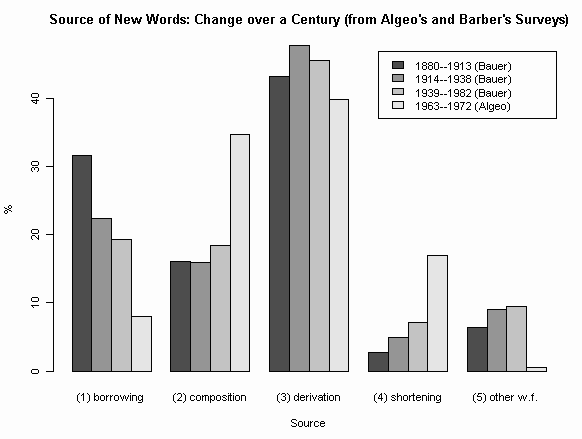
昨日の記事[2011-09-21-1]でも述べた通り,Bauer と Algeo の調査では前提がいくつか異なっている.特に Bauer では品詞転換が考慮に入れられていないので,比較条件を揃えるために,Algeo のデータから "Shifts" として区分されている数値を除いてあることにも注意されたい( "Shifts" は調査語彙全体の14.2%を占める小さくはない数値である.こちらの詳細区分を参照).また,Algeo の "Blends" は,今回のグラフ作成では "shortening" の一種として扱った.
Algeo の数値は Bauer の第3期の数値と開きこそあるが,新語ソースの傾向としてはおもしろいほどに一致している.Bauer の示唆する通時的な傾向が,Algeo によって著しく強調されて示されていると言ったらよいだろうか.比較基準の差異という問題は常について回るだろうが,互いに支持する結果となったのが興味深い.
・ Algeo, John. "Where Do the New Words Come From?" American Speech 55 (1980): 264--77.
・ Bauer, Laurie. Watching English Change: An Introduction to the Study of Linguistic Change in Standard Englishes in the Twentieth Century. Harlow: Longman, 1994.
2011-09-21 Wed
■ #877. Algeo の現代英語の新語ソース調査 [pde][word_formation][loan_word][statistics][lexicology][neologism]
[2011-09-17-1], [2011-09-18-1], [2011-09-19-1]の記事で,Bauer (35, 38) による1880--1982年の約1世紀のあいだの新語ソースの変遷について触れてきた.現代英語の新語ソースの内訳が通時的にいかに変化してきたかに関する研究は他にあまり見たことがないが,共時的な内訳の調査であれば昨日の記事「#876. 現代英語におけるかばん語の生産性は本当に高いか?」 ([2011-09-20-1]) で触れた Algeo がある.
Algeo の調査は1963年以降の新語を収録した Barnhart の辞書から無作為抽出した1000語に基づくもので,時期区分で言えば Bauer の第3期(1939--82年)のおよそ後半に相当する時期の新語に関する調査ということになる.新語ソースの分類が Bauer に比べてずっと細かいのが特徴で,分類ラベルを眺めるだけでも形態論や語彙論の概要がつかめてしまいそうな細かさだ.また,Bauer は 品詞転換 (conversion) を調査対象に含めていないが,Algeo は "Shifts" の1部として含めている.ただし,この "Shifts" には意味変化の例も含まれており,新語の定義の問題(新語形のことなのか,あるいは新語義も含むのか)を考えさせられる.
Algeo の論文の Appendix (273--76) に掲載されている,詳細な新語ソース区分とその内訳の数値をこちらのページに転載したので,参照されたい.
上記のように Bauer と Algeo では調査対象とした辞書,時代,新語ソース区分,前提としている新語の定義が一致していないので直接比較はできないものの,両者の与える数値はいずれにせよ概数であるから,合わせて現代英語の新語ソースに関する傾向を示唆するものとして大いに参考になるだろう.
現代英語の新語については,[2011-01-16-1]の記事「#629. 英語の新語サイト Word Spy」を参照.
・ Bauer, Laurie. Watching English Change: An Introduction to the Study of Linguistic Change in Standard Englishes in the Twentieth Century. Harlow: Longman, 1994.
・ Algeo, John. "Where Do the New Words Come From?" American Speech 55 (1980): 264--77.
・ Barnhart, Clarence L., Sol Steinmetz, and Robert K. Barnhart, eds. The Barnhart Dictionary of New English since 1963. Bronxville, N.Y.: Barnhart, 1973.
2011-09-20 Tue
■ #876. 現代英語におけるかばん語の生産性は本当に高いか? [blend][productivity][pde][pde_language_change][word_formation][statistics][lexicology]
[2011-01-18-1]の記事「#631. blending の拡大」で,現代英語においてかばん語が増加している件について取り上げた.かばん語は,現代英語の傾向の1つとして Leech et al. が指摘している "densification" (50) の現われと考えられそうである([2011-01-12-1]の記事「現代英語の文法変化に見られる傾向」を参照).多数のかばん語の例を示されれば,確かにさもありなんと直感されるところではある.しかし,[2011-09-17-1]の記事「#873. 現代英語の新語における複合と派生のバランス」で触れたとおり,Bauer の新語調査によれば,新語におけるかばん語の割合は1880--1982年の期間で p < 0.05 のレベルでも有意な増加を示していない(ただし絶対数は増加している).複数の観察者が指摘しており,私たちの直感にも適うかばん語の増加傾向と,客観的な統計値とのあいだに差があるのはどういうことだろうか.
1つには,Bauer の調査対象期間が1982年で終わっているということがあるだろう.当時の客観的状況と2011年の時点で私たちの抱いている直感とが食い違っていても不思議はない.この30年ほどの間に blending が激増したという可能性も考えられる.
もう1つ,直感と数値のギャップを説明し得る要因がある.この点に関して,Algeo の調査を紹介したい.多くの語彙研究が OED 系の辞書を利用しているが,Algeo はそれとは別系列の辞書を利用して独立した新語調査を行なった.彼の採った方法は,1963年以降の新語を収録した Barnhart の辞書から1000語を無作為抽出し,それをソースや語形成ごとに振り分けるというものである.その調査によると,かばん語は調査した新語語彙全体の4.8%を占めるにすぎず,他の主要な語形成のなかでは目立たないカテゴリーであるという結果となった.しかし,Algeo (271) はこの数値は過小評価だろうと述べている.
Last in numerical importance as a source of new words is blending. Less than a twentieth of our new words have been formed in that way (4.8 percent); however, blending is more popular than that statistic suggests. Its principal areas of use are popular journalism and advertising. Time magazine and Madison Avenue dearly love a blend. Most of the popular coinages are nonce forms that were unreported in the Barnhart dictionary and consequently are not included in these statistics. But every new word begins as a nonce form, so a source that is prolific of nonce forms today may be expected to increase its contribution to the general vocabulary tomorrow. Blending may look like a long shot, but the smart money will keep an eye on it.
"nonce-form" あるいは "nonce-word" (臨時語)に blending が多用されるというのは客観的に確かめにくいが,直感には適う.形態の生産性 (productivity) とは何を指すかという問題は,[2011-04-28-1], [2011-04-29-1], [2011-05-28-1]の記事でも触れてきたように,明確な解答を与えるのが難しい問題である.この問いは,何を(辞書に掲載するに値する)語とみなすかというもう1つの難問にも関係してくる([2011-03-28-1]の記事「#700. 語,形態素,接辞,語根,語幹,複合語,基体」を参照).blending の真の生産性は辞書や辞書に基づいた統計値には現われにくいが,言語使用の現場において活躍している語形成であることは恐らく間違いない.問題は,この主観的評価を,いかにして客観的に支持し得るかという方法の問題なのではないか.
・ Leech, Geoffrey, Marianne Hundt, Christian Mair, and Nicholas Smith. Change in Contemporary English: A Grammatical Study. Cambridge: CUP, 2009.
・ Bauer, Laurie. Watching English Change: An Introduction to the Study of Linguistic Change in Standard Englishes in the Twentieth Century. Harlow: Longman, 1994.
・ Algeo, John. "Where Do the New Words Come From?" American Speech 55 (1980): 264--77.
・ Barnhart, Clarence L., Sol Steinmetz, and Robert K. Barnhart, eds. The Barnhart Dictionary of New English since 1963. Bronxville, N.Y.: Barnhart, 1973.
2011-09-19 Mon
■ #875. Bauer による現代英語の新語のソースのまとめ [loan_word][word_formation][lexicology][pde][pde_language_change][statistics][lexicology]
過去2日の記事[2011-09-17-1], [2011-09-18-1]で,Bauer の調査結果に基づいて新語のソースを概観した.類似した調査はそれほど多くないようなので,Bauer のデータ (35, 38) は貴重だと思い,もう少し分析してみた.(データは整理してHTMLソースに載せておいた.)
新語のソースを大きく2分すると,借用 (borrowing) と語形成 (word formation) のカテゴリーが得られる.借用は借用元言語によって数種類に下位区分され,語形成も主として形態論の観点から数種類に下位区分される.あまり細かく区分しても大きな傾向が見にくくなるので,借用は借用元言語を区別せず,語形成は4種類に大別し,(1) borrowing, (2) composition, (3) derivation, (4) shortening, (5) other word formations の5区分で集計しなおした.以下のグラフでは,ソースごとの3期にわたる割合の変化がつかみやすいように百分率で表示してある.例えば,第1期1880--1913年を示す黒棒の数値を足し合わせると100%となる,という読み方である.
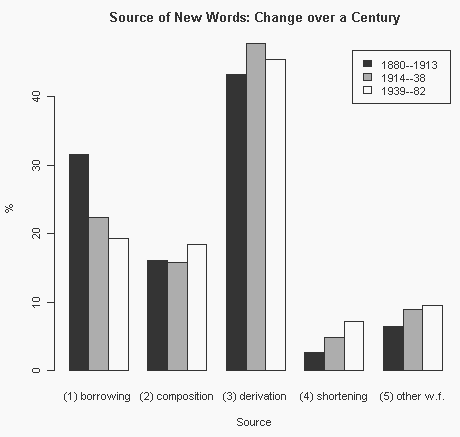
全体として,対象となった約100年間の通時的変化は p < 0.0001 のレベルで有意差が出た.そのなかでも借用の激減が最も顕著な変化である(同じく p < 0.0001 のレベルで有意).一方,各時期で合わせて6割ほどを示す composition と derivation の主要2カテゴリーは,時期によってそれほど変化していない( p < 0.05 レベルで有意差なし).また,全体での割合からすると目立たない shortening や他の語形成が順調に増加していることも見逃してはならない(shortening については,p < 0.001 のレベルで有意).カテゴリーの区別の仕方によって傾向の見え方も変化するので,同じデータを様々な角度から眺めることが必要だろう.
この3日間の記事のグラフをまとめてみられるように,3記事を「##873,874,875」で連結したので比較までに.
・ Bauer, Laurie. Watching English Change: An Introduction to the Study of Linguistic Change in Standard Englishes in the Twentieth Century. Harlow: Longman, 1994.
2011-09-18 Sun
■ #874. 現代英語の新語におけるソース言語の分布 [loan_word][lexicology][pde][pde_language_change][statistics]
昨日の記事「現代英語の新語における複合と派生のバランス」 ([2011-09-17-1]) で取り上げた Bauer の調査は,現代英語の新語を構成する要素の起源,つまりソース言語をも考慮に入れている (32--33, 34--36) .(データはHTMLソースを参照.)
新語における借用比率は,1880--1913, 1914--38, 1939--82年の3期にわたり 31.4% -> 22.3% -> 19.2% と大きく目減りしている.現代英語においては,中英語や初期近代英語に比べ,全体的に借用に依存する程度が急減しているのがわかる.借用元言語ごとに状況を見てみよう.以下のグラフは,Bauer (35) に掲載されている表に基づいて作成したものである.
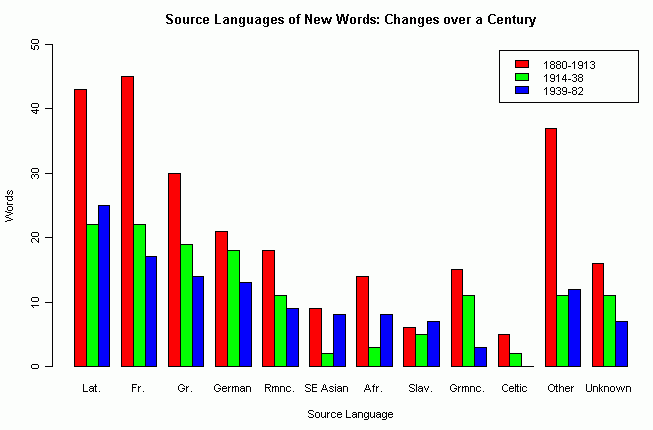
統計的には Fr. (French) と Grmnc (Other Germanic) において p < 0.05 のレベルで減少の有意差が認められるものの,特定のソース言語が全体的な減少に関与しているというよりは,ソース言語にかかわらず全般的に減少傾向が続いているものと読める.
注意すべきは,1880--1913年の Other カテゴリーが際立っていることだ.ここには,オーストラリア,ポリネシア,アメリカの土着言語からの借用が多く含まれているという.なぜこの時期にこれらの言語からの借用が多かったかという問題は,別途調査して考察する必要があるだろう.
Bauer の第3期の終了年である1982年より,約30年が経過している.以後,英語の借用離れは続いているのだろうか.これも興味深い問いである.
・ Bauer, Laurie. Watching English Change: An Introduction to the Study of Linguistic Change in Standard Englishes in the Twentieth Century. Harlow: Longman, 1994.
2011-09-17 Sat
■ #873. 現代英語の新語における複合と派生のバランス [romancisation][compound][derivation][lexicology][pde][word_formation][productivity][statistics][pde_language_change]
英語語彙の歴史は,供給源という観点から,大雑把に次のように概括される.古英語では複合 (composition) と派生 (derivation) が盛んだったが,中英語から初期近代英語にかけては借用 (borrowing) が著しく,後期近代英語以降は再び複合と派生が伸張してきた.この語彙史の流れを受けて,現代は新語の供給源を,借用よりも既存要素(それ自体は本来語とは限らない)の再利用に多く負っている時代ということになる.では,現代英語を特徴づけるとされる複合と派生の2つの語形成では,どちらがより生産性が高いといえるだろうか.Potter (69--70) は,両者のバランスはよく取れていると評価している.
German and Dutch, like ancient Greek, make greater use of composition (or compounding) than derivation (of affixation). French and Spanish, on the other hand, like classical Latin, prefer derivation to composition. Present-day English is making fuller use of both composition and derivation than at any previous time in its history.
もちろん,両者のバランスが取れているからといって他言語よりも優れた言語ということにはまったくならない.ただし,ゲルマン語派とロマンス語派の語形成の特徴を兼ね備えていることにより,英語がいずれの立場からも「近い」言語と感じられるという効果はあるかもしれない(関連する議論は[2010-05-27-1]の記事「英語のロマンス語化についての評」を参照).ゲルマン系でもありロマンス系でもあるという現代英語の特徴は,語形成に限らず語彙全体にも言えることである.
さて,Potter は上記のように複合と派生の好バランスを指摘したが,生産性を量的に測ったわけではなく,他の主要なヨーロッパ語あるいは古い英語との比較において評価したにすぎない.この点についてより客観的に調査したのが,Bauer (32--33, 36--39) だ.Bauer は The Supplement to the Oxford English Dictionary (1972--86) を用いた無作為標本調査で,対象に選ばれた本来語要素から成る新語1559語を初出年により (1) 1880--1913, (2) 1914--38, (3) 1939--82 の3期に区分して,造語法別に語を数えた.区別された造語法とは,Abbreviations, Blends, Shortenings, Compounds, Prefixation, Suffixation, Names, Neo-classical compounds, Simultaneous prefix and suffix, Other の10種類である.
Bauer (38) の掲げた表のデータを Log-Likelihood Tester, Ver. 2 に投げ込んで統計処理してみた(データはHTMLソースを参照;グラフは以下を参照.).全体として時期別の差は p < 0.05 のレベルで有意であり,分布の通時的変化が観察されると言ってよいだろう.次に造語法別に変化を見てみると,Abbreviations が p < 0.01 のレベルで有意な増加を示し,Suffixation と Neo-classical compounds がそれぞれ p < 0.05 のレベルで有意な減少を示した.その他の造語法については,3期にわたる揺れは誤差の範囲内ということになる.Bauer (37--38) は,Blends の増加を有意であると示唆しており,しばしば指摘される同趣旨の傾向を支持しているようだが,計算上は p < 0.05 のレベルでも有意差は認められなかったので注意が必要である([2011-01-18-1]の記事「blending の拡大」を参照).
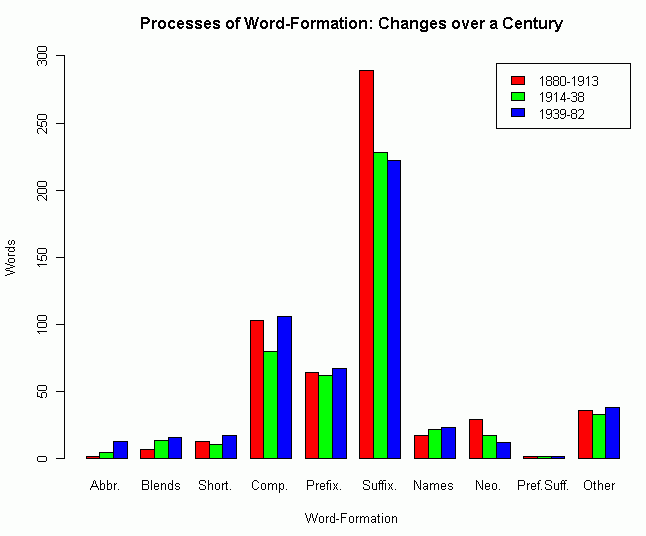
複合系 (Compounds, Neo-classical compounds) と 派生系 (Prefixation, Suffixation, Simultaneous prefix and suffix) で比べると,3時期を通じて後者の割合は前者の割合の2.7倍程度で圧倒している(以下のグラフを参照).数値的には,派生のほうにバランスが偏っているようだ.
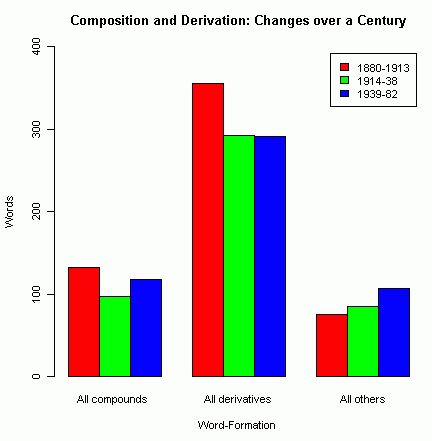
・ Bauer, Laurie. Watching English Change: An Introduction to the Study of Linguistic Change in Standard Englishes in the Twentieth Century. Harlow: Longman, 1994.
・ Potter, Simon. Changing English. London: Deutsch, 1969.
2011-09-11 Sun
■ #867. Barber 版,現代英語の言語変化にみられる傾向 [pde][language_change][pde_language_change][elf][wsse]
最近,現代英語の言語変化の傾向について調べる機会をもった.関連する話題は,これまでにも以下のような記事(とそこから張られているリンク先の記事)で扱ってきた.
・ 「#860. 現代英語の変化と変異の一覧」 ([2011-09-04-1])
・ 「#795. インターネット時代は言語変化の回転率の最も速い時代」 ([2011-07-01-1])
・ 「#625. 現代英語の文法変化に見られる傾向」 ([2011-01-12-1])
・ 「#622. 現代英語の文法変化は統計的・文体的な問題」 ([2011-01-09-1])
・ 「#339. 英語史が近代英語期で止まってしまったかのように見える理由」 ([2010-04-01-1])
・ 「#386. 現代英語に起こっている変化は大きいか小さいか」 ([2010-05-18-1])
(以上を一括した,##860,795,625,622,339,386 もどうぞ.)
一般的な定義に従って現代英語を20世紀以降とすると,その前半と後半とでは英語を取り巻く環境は激変している.また,1990年代半ば以降には,ELF (English as a Lingua Franca) という表現も聞かれるようになり,世界の中での英語の位置づけは,21世紀中も安定することはなく,ますます変化してゆくものと思われる.英語の社会言語学的な立場が変化するにつれて,英語が言語的にも変容してゆくだろうということは容易に想像されよう.
Barber は,20世紀半ばの時点での英語(主として彼が "Received Standard" と呼ぶイギリス標準英語)の言語変化について考察しているが,そこには2つの潮流が認められると述べている.
On the one hand, there has been a trend towards greater uniformity, a levelling out of differences; on the other hand, there has been an increased reluctance to accept as a norm what has hitherto been considered the standard form of the spoken language. In sum the effect has been to make the language more mixed. (16)
非標準変種を含めた様々なイギリス英語内の変種に特徴的だった言語項目が標準変種へと忍び込んできているという潮流と,標準変種の地位そのものが低下してきているという潮流である.これは,標準と非標準が混合しながらも,足して2で割ったような同質的な変種が生まれつつあるという洞察と読めるだろう.この洞察から推測できることは,標準英語に生じている言語変化(の一部)は,標準英語に限定された視点からすれば新しい言語変化とみなすことができるかもしれないが,視野を広げて見れば,単に非標準変種にすでに存在していた言語項目が標準変種へ移入してきただけということもありそうだ,ということである.これは,方言借用 (dialectal borrowing) という過程に近い.Barber 自身の表現で言えば,次の引用で赤字で示したように "changes in acceptance" (受容の変化)ということになる.
Because of the change which is going on in the concept of standard English, and because of the social changes of the post-war period, some of the linguistic changes which we shall note will be changes in acceptance, rather than changes in actual usage. Usages which are not new, but which have previously been considered non-standard, are now coming to be accepted as standard by increasing numbers of educated speakers (though not always by the speaker of R. S. [Received Standard] proper). (28--29)
Barber の説く現代イギリス標準英語の言語変化の潮流は,一言でいえば "dialectal mixing" の傾向と要約できるが,彼の達識は,20世紀半ばという比較的早い段階で,同じ潮流がイギリス標準英語だけでなく世界英語にも観察されることを指摘した点に見いだされる.(アメリカ英語を強力な基盤としながらも)世界中の英語変種が混ざり合い,緩やかに均一化しているのではないかという観察である.
[W]ith the great increase in world-wide communications, it is probable that the various forms of English spoken in the world are now influencing one another more than formerly, and that the trend to greater dialectal mixing is therefore taking place in English on a world scale. (21)
これは,Crystal の提起する WSSE (World Standard Spoken English) に近い考え方である.[2010-10-09-1]の記事「アメリカ英語と conversion / diversion」で触れたように,相反する傾向,世界中の英語がちりぢりになって行く diversion の傾向を無視するわけにはいかないが,ELF が暗黙に目指している世界標準英語の確立という観点からは,Barber の1964年の観察と直感は評価に値すると考える.
・ Barber, Charles. Linguistic Change in Present-Day English. Alabama: U of Alabama P, 1964.
2011-09-04 Sun
■ #860. 現代英語の変化と変異の一覧 [pde][language_change][pde_language_change][exclamation_mark]
[2010-05-31-1]の記事「現代英語に起こっている言語変化」と[2011-01-11-1]の記事「現代英語の文法変化の一覧」で,現代英語に生じている言語変化の一覧を挙げたが,今回はその拡大版を作った.網羅的な一覧は作り得ないので,Barber, Bauer, Fennell, Potter, Leech et al. その他の諸文献で取り上げられているような言語変化および変異の項目を,参照用にまとめたものとして理解されたい.含めた項目の広がりと細かさは恣意的だが,中心に据えたのは "PDE linguistic changes and variations in spoken and written varieties of present-day Standard British and/or American English" である.より詳しい一覧としては,中尾を参照されたい.
通時的変化と共時的変異の区別は曖昧であり,明確に言語変化とみなせるかどうか疑わしい例もあるかもしれない.また,逸話や直感のレベルで言語変化と言い立てられているe例も含まれている.さらに,すべて現代英語で進行中の変化ではあるが,多くは現代英語で始まった変化ではない.多くは近代英語期から,あるいは中英語期以前から継続している変化であり,前史をもっている点にも注意したい.いずれの項目も,現代英語に生じている変化としてみなせるかどうか,検証するに値する項目ではある.
phonology
- centering of short vowels (Barber 42): yes, good
- change of /ɔː/ to /ɔ/ before /f/, /s/, and /θ/ (Barber 43): off, lost, cloth
- closer /ɔː/: lord used to be pronounced like lard today
- Continental pronunciation (Barber 72--74, Potter 31--32): Seine, Cherbourgh, Majorca, Sofia, Buenos Aires; quasi-, nuclei
- de-syllabification of pp adj. with -ed (#776): aged, beloved
- de-syllabification of /iə, uə/ to /i-ə, u-ə/ (Potter 18--19)
- diphthongisation of /iː/ and /uː/ (Barber 44--45): tea, two
- dramatic fronting of /uː/ and /ʌ/ in RP (Bauer 114--21)
- final /iː/ for /i/ (Barber 46--47): pretty, Derby
- fluctuation in pronunciation (#488, #766): applicable, dilemma, status
- h-dropping (#462): herb, homage
- initial /h/ for /wh/: where, what
- instable pronunciation of triphthongs (Potter 19--20): [faə], [fɑə], [fɑː]] for [faiə]
- intrusive (linking) -r (#500): the idea(r) of, law(r) and order
- intrusive stops (Barber 58--59): fan(t)cy, warm(p)th, leng(k)th
- loss of final alveolars (Barber 53--54): no(t) bad, ol(d) man, half pas(t) five
- loss of plosives (Barber 54): knocked, East Coast
- loss of /p/ from initial /ps/ and /pt/ (Barber 55): pseudo, psyche
- new weak forms of pronunciation (Barber 64): /srait/ (that's right), /fjuˈlaik/ (if you like), /ˈtsɔːl ˈrait/ (it's all right)
- Northern Cities Shift (#396)
- noun-verb stress alternation (#803, #804, #406)
- simplification of double consonants (Barber 54--55): a good deal, upside-down, lamp-post, prime-minister
- Southern Hemisphere Shift (#402)
- spelling pronunciation (#211, #212, #379): often, forehead
- spread of /ə/ in unstressed syllables (Barber 48--49): ability, women, useless, engine
- spread of glottal stops (Barber 60--61): butter, batman, button, not yet
- vocalic influence of "dark l (Barber 47--48): revolve, solve; salt, falter; milk
- voicing of intervocalic consonants (Barber 57): letter, better, British
- vowel shift in Estuary English (#465)
- word stress shift (#488, #769; #321, #342, #366): controversy, harass, Caribbean
- /ɛ/ for /eɪ/ (#541, #543): says, against
- yod-dropping (#841): dew, enthuse, lewd, new, suit, tune
morphology
- acronyms, initialisms, and alphabetisms (#625, #817): EU, UNESCO, asap
- active conversion (#394): to pluto
- active blending (#631, #625): electrocute, Singlish
- active shortening (Barber 89--91): telly, mike, sub, polio, bra
- affixation (#732, #133, #593, #420): -dom, -ish, -wise, super-, mini-
- back-formation (#108): baby-sit, escalator, ism, enthuse, liaise
- change in formation of new words (Bauer 38--40): blends and compounds grow while suffixation and neo-classical compounds decline
- conversion of phrasal verbs to nouns (Potter 171--73): breakout, getaway, layout, leftover, setup, walkout
- generalisation of the s-plural (#121, #161, #482): thesauruses, mouses, oxes
- headless compound (#420): pickpocket, sell-out
- -ic for -ical (Barber 115): comic, botanic, politic
- monosyllabism (Potter 76--78): ad, jet, op, quake
- regularisation of irregular verb conjugations (#178, #528): dreamed for dreamt, wedded for wed
- spread of the s-genitive to non-human nouns (#425): today's newspaper, the book's cover
- suffixation for semantic differentiation (Potter 74--76): emergency / emergence, continuance / continuation / continuity
- variants of the preterite of verb (#312): dove / dived, sung / sang, swum / swam
syntax
- analytical comparison of disyllabic adjectives (#403, #456, #425; Bauer 51--61): more polite, most polite for politer, politest
- change in case inflections of personal pronouns (Bauer 88): between you and I for between you and me; than myself to avoid the choice of either I or me
- change in non-finite clausal complementation (part of "Great Complement Shift") (Leech et al. 205)
- decline of wh-relatives in AmE (#424, #425; Bauer 66--83)
- decline of whom (#622)
- decline of auxiliary verbs like shall, ought (to), need(n't) (#677)
- decline of passive constructions (Leech et al. 164)
- development of new, auxiliary-like uses of certain lexical verbs: wanna for want to,
- do-support for have in BrE: Have you any money? and No, I haven't any money → Do you have / have you got any money? and No, I don't have any money / I haven't got any money
- do-support for be (Potter 132): Why don't you be a good boy?, Why on earth doesn't the fellow be reasonable?
- due to as a compound preposition (Barber138): Due to heart-failure, he suffered an early death.
- elimination of shall as a future marker in the first person (#301)
- expansion of phrasal verbs and compound verbs (Barber 140): run down; build up, start up
- extension of the progressive to new constructions (especially modal, present perfect and past perfect passive progressives: the road would not be being built / has not been being built / had not been being built / They are remembering the days of their childhood, You are surely imagining things
- fixed order of attributive adjectives (Potter 152--56): his five short brilliant creative years
- fluctuation of prepositions in phrases (#301): different to for different from
- further auxiliation of semi-auxiliaries and modal idioms (#64): gonna, have got to, be supposed to
- gerunds as attributives (Fennell 174): the come-backing Australian tennis player, Claire X is a rapidly becoming confused mother of four
- hyphenated attributives (Potter 106--107): an off-the-cuff opinion, round-the-clock discussions, hard-to-get-at volumes
- increase in negative and verbal contractions: is'nt, it's
- increase in the number and types of multi-word verbs (expanded predicates): phrasal verbs, have / take / give a + noun
- increase in title + name: Prime Minister Margaret Thatcher for Mrs Thatcher, the Prime Minister, young Lambeth housewife Amy Green for Mrs Green, a young Lambeth housewife
- less use of no-negation in contrast to not-negation (Leech et al. 241)
- like, same as, and immediately as conjunctions (#312)
- longer VPs (catenatives) (Fennell 174): He appears to wish to be able to carry on being examined by the same doctor.
- more use of adjectives as adverbs (#312): They pay them pretty good.
- more zero-relatives and that-relatives (Bauer 66--83)
- more use of less instead of fewer with countable nouns: less people
- more use of the preterite for the perfect (Fennell 175): I bought a new car for I've bought a new car
- more use of the get-passive (Leech et al. 164): get frightened, get mixed
- more use of the mediopassive (Leech et al. 165): Oilcloth wears well, Thr routes are designed to bicycle in a few hours.
- (multiple) noun adjuncts (#625, #425; Potter 107--13, Fennell 175): World Court, recreation facilities, for health reasons, on efficiency grounds, weapons technology; World Heath Organization, Trades union congress centenary, New York City Ballet School instructor, railway station waiting room murder inquiry verdict
- "noun disease" (Potter 100--05): London's growth is rapid for London is growing rapidly
- number concord of collective nouns (#312; Bauer 61--66): The Government has/have been considering further tax cuts.
- omission of the definite article (Potter 144--46): (the) university, (the) Government, (the) radio, all (the) winter
- omission of have and do (Barber 136--37): we done it, they been, you seen; What you want that for?, Where you think you're going?
- omission of Do you in questions (Barber 137): Like a cigarette?, Have a drink?
- omission of that in now that and so that (Barber 138)
- placement of frequency adverbs before auxiliary verbs even if no emphasis is intended: I never have said so
- plural attributives (Bauer 48): drugs courier for drug courier
- positive tags as afterthoughts (Potter 160): We all agree on this, or do we?, We know in our hearts that we shall be rewarded, or do we?
- revival of the 'mandative' subjunctive, probably inspired by formal US usage (#312, #325, #326): we demand that she take part in the meeting
- sentences becoming shorter (Barber 143)
- sort of and kind of as adverbs (Barber 138): meaning so to speak, if that is the right word for it
- spread of 'singular' they to formal and standard usage (#275; Bauer 148): Everybody came in their car
- suppressed prepositions (Potter 140--41): agree (with), approve (of), compensate (for), protest (against), cope (with)
- syntactic contamination (#737; Barber 139): both A but also B; between A to B, comprise of
- this and that as intensive adverbs (Potter 147): It is not all that simple.
semantics
- change in usage and meaning of words (#823, #755, #301): uninterested / disinterested, literally, hopefully
pragmatics
- decline of she for ships and countries (#852)
- decline of honorific vocatives such as Mr and Sir
- democratised mode of address as by first-names (Bauer 141--45)
- increase in questions (Leech et al. 242)
- popularisation of political correctness (#115): Ms, chairperson; refuse collector
- second person plural pronouns (#312, #529): y'all, you guys
lexicon
- change in sources of new words (Bauer 35--36): English grows while French, Latin, and Greek decline
- Cockney rhyming-slang since the World Wars (Barber 103): trouble and strife (wife), half-inch (to pinch), titfer (hat)
- general growth in vocabulary (#629, #623)
- Greco-Latin scientific vocabulary and its popularisation (Potter 90--98): ISV (International Scientific Vocabulary) such as pediatrics, arthritis, euphoria, claustrophobia, inferiority complex
- growth in e-vocabulary as a result of e-revolution
- new intensifiers (Barber 123--24): smashing, shattering, wizard, bang-on, super, super-duper, massive, fabulous
- new lexical euphemisms (Barber 125): slump / depression / recession / downturn
- proper names and trade names (Barber 95--97): diesel, kodak, Hoover, Biro
- revival of old (esp. war-related) words: frigate, corvette, armour
spelling
- -ise / -ize in BrE (#314; Bauer 134--35): emphasise, criticise, characterise, summarise, specialise
- "pronunciation spelling" (#799, #825): lite, thru, warez
punctuation
- fewer exclamation marks and semi-colons (Leech et al. 245)
- growth in parenthetic sentences (Barber 143): Boxer Bill Smith (he will be twenty-four to-morrow) has signed a contract to fight. . .
- increase of quoted speech (Leech et al. 248)
- less use of apostrophes (Bauer 132--33): the 1969s
- less use of hyphens (Potter 58--59): yearbook for year-book or year book; today for to-day
- more use of quotes (Potter 56--57): to impress the uninitiated?
- preference for lowercase (Potter 59--60): neo-platonic for Neo-Platonic or neo-Platonic
- smileys and emoticons (#808): :-) and :-(
- unindented address lines (Bauer 132)
・ Barber, Charles. Linguistic Change in Present-Day English. Alabama: U of Alabama P, 1964.
・ Bauer, Laurie. Watching English Change: An Introduction to the Study of Linguistic Change in Standard Englishes in the Twentieth Century. Harlow: Longman, 1994.
・ Fennell, Barbara A. A History of English: A Sociolinguistic Approach. Malden, MA: Blackwell, 2001.
・ Leech, Geoffrey, Marianne Hundt, Christian Mair, and Nicholas Smith. Change in Contemporary English: A Grammatical Study. Cambridge: CUP, 2009.
・ Potter, Simon. Changing English. London: Deutsch, 1969.
・ 中尾 俊夫 著,児馬 修・寺島 迪子 編 『変化する英語』 ひつじ書房,2003年.
2011-06-12 Sun
■ #776. 過去分詞形容詞 -ed の非音節化 [pde][phonetics][language_change]
[2011-01-30-1]の記事「独立した音節として発音される -ed 語尾をもつ過去分詞形容詞」と[2011-04-09-1]の記事「独立した音節として発音される -ed 語尾をもつ過去分詞形容詞 (2)」で,aged, jagged などが2音節として発音され得る事実について論じた.aged については被修飾名詞によって揺れがあることに言及したが,aged に代表される過去分詞形容詞 -ed の発音の揺れは,通時的変化が現在進行中であることを示唆しているものと考えられる.その変化の方向は,過去に無数の -ed に生じてきたとおり,非音節化の方向である.Bolinger (148fn) は,-ed の非音節化を,19世紀から20世紀にかけて進行してきた最も印象的な音韻変化であると評している.
The reduction of -ed has been perhaps the most striking phonological change in English in the past century and a half. Poutsma (Part II, 則2, p. 569) quotes Bradley to the effect that "Within the memory of living persons it was still usual in the reading of the Bible or the Liturgy to make two syllables of such words as loved or changed, which are now pronounced in one syllable." As a child I gave striped and streaked two syllables each. The disintegration continues; I have heard jagged pronounced as one syllable by a-twelve-year old.
屈折語尾としての -ed の運命が非音節化にあることは,英語史の流れから明らかである.その大きな潮流に抗う小さな潮流として,2音節を保持し強弱のリズムを堅守するという韻律的な要因がある.換言すれば,この小さな潮流は大きな潮流をせき止めることはできなくとも,進行を遅らせるくらいには作用していると考えられる.だが,その作用も徐々に限界に達しつつあるということだろうか.aged, beloved, naked, wicked などは頻度が比較的高いが,これらの -ed が独立した音節でなくなる日は遠くないのかもしれない.
・ Bolinger, Dwight L. "Pitch Accent and Sentence Rhythm." Forms of English: Accent, Morpheme, Order. Ed. Isamu Abe and Tetsuya Kanekiyo. Tokyo: Hakuou, 1965. 139--80.
2011-01-12 Wed
■ #625. 現代英語の文法変化に見られる傾向 [pde][language_change][grammaticalisation][colloquialisation][americanisation][sociolinguistics][pde_language_change]
Svartvik and Leech によると,現代英語の書き言葉文法の変化は以下の3つの傾向を示しているという (206).
・ Grammaticalization --- Items of vocabulary are gradually getting subsumed into grammatical forms, a well-known process of language change.
・ Colloquialization --- The use of written grammar is tending to become more colloquial or informal, more like speech.
・ Americanization --- The use of grammar in other countries (such as the UK) is tending to follow US usage.
1点目の grammaticalization ( see [2010-06-18-1] ) は現代英語に特有の変化(のメカニズム)というわけではないが,Svartvik and Leech は現代英語に顕著だと考えているのだろうか.著者らの念頭には,例えば[2010-05-31-1]や昨日の記事[2011-01-11-1]で触れた semi-auxiliaries や extension of the progressive があるのだろう.
2点目の colloquialization は現代の談話の民主化傾向 ( democratization ) とも関連するが,単純に書き言葉が話し言葉へ同化しつつあるということを意味するわけではない.同様に,3点目の Americanization が単純に BrE が AmE 化しつつあるということを意味するわけではない.この2つの傾向は確かに部分的に重なり合っており,それぞれ自身も単純に記述できない複雑な過程である.
上述の著者の1人である Leech が別の共著者と著わした Leech et al. のなかでは,もう1つの傾向として "densification" (50) あるいは "the effects of 'information explosion'" (22) が指摘されている.それによると,増大し続ける情報をできるだけコンパクトに効率よく言語化しようとする欲求が高まっているという.その具体的現われが,brunch, smog などの かばん語 ( blend ) や AIDS, NATO などの 頭字語 ( acronym ) や New York City Ballet School instructor などの名詞連鎖だろう.
かりに現代英語の書き言葉文法の変化に関して colloquialization, Americanization, densification などといった傾向を受け入れるとすると,次に文法変化と社会変化の相関関係を疑わざるを得ない.もし社会変化が文法変化の方向を定めているとすれば,それは実に興味深い.従来,確かに社会変化が語彙変化を誘発するということは言語の常であったし,言語接触や方言接触が言語の諸側面に変化の契機をもたらすことも常であった(実際に Americanization は後者に相当する).しかし,それ以外の社会の変化,より具体的に言えば "the broader changes in the communicative climate of the age" が,間接的ながらも,言語のなかでもとりわけ抽象的な部門である文法に影響を及ぼすというのは,決して自明のことではなかった.
Leech et al. は,社会変化の文法変化に及ぼす影響について次のように述べている.
More often than not there are links between grammatical changes, on the one hand, and social and cultural changes, on the other. Such links may not be as obvious as the links between social change and lexical change, and they are certainly more indirect. Again and again, however, the authors have discovered that, especially when it comes to explaining the spread of innovations through different styles and genres, apparently disparate grammatical 'symptoms' can be traced back to common 'causes' at the discourse level. Exploring the connections between the observed shifts in grammatical usage (the nuts and bolts of the system, as it were) and the broader changes in the communicative climate of the age, which are reflected in the performance data that the corpora are made up of, is a fascinating challenge not only for the linguist. (Leech et al. 22)
・ Svartvik, Jan and Geoffrey Leech. English: One Tongue, Many Voices. Basingstoke: Palgrave Macmillan, 2006.
・ Leech, Geoffrey, Marianne Hundt, Christian Mair, and Nicholas Smith. Change in Contemporary English: A Grammatical Study. Cambridge: CUP, 2009.
Powered by WinChalow1.0rc4 based on chalow